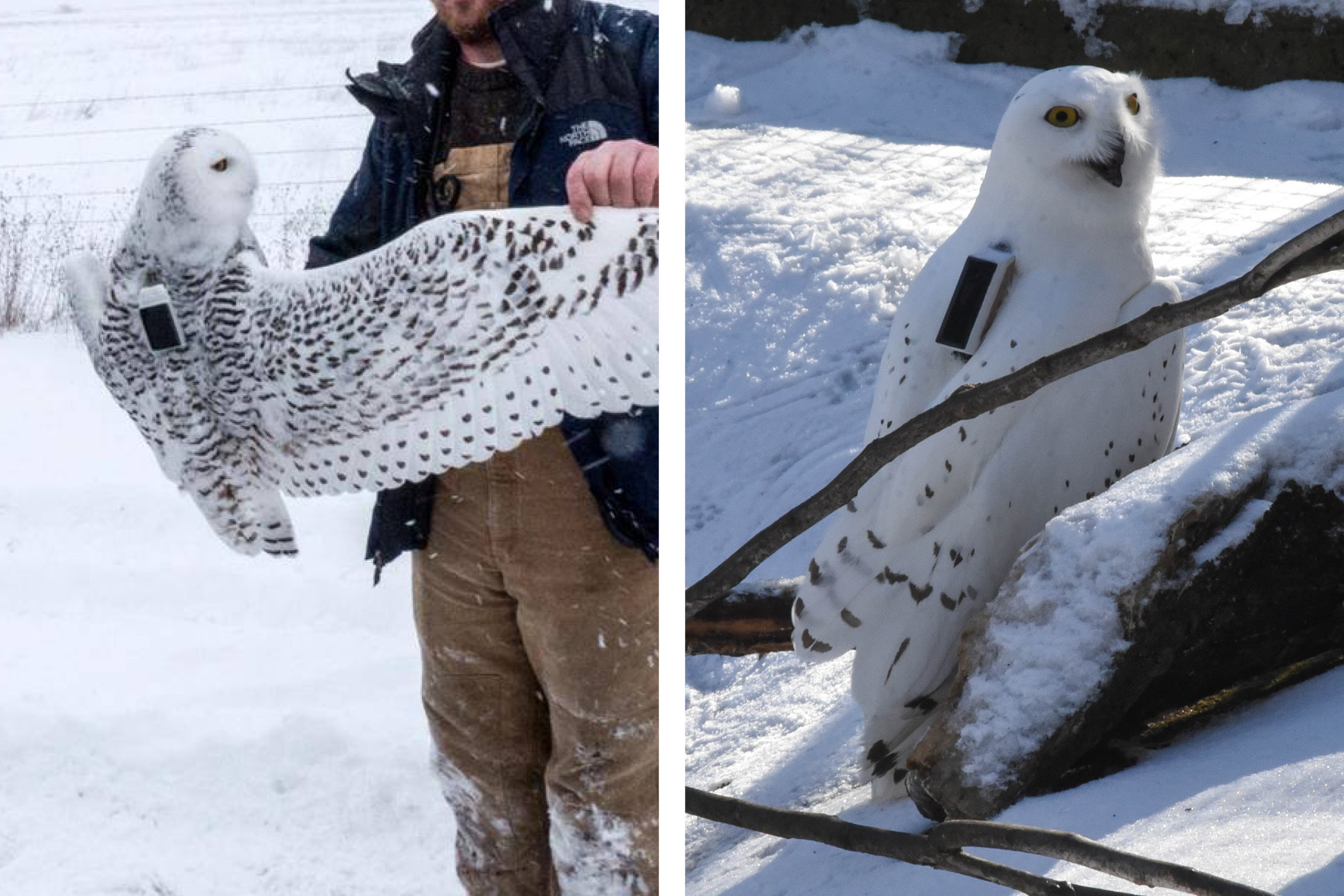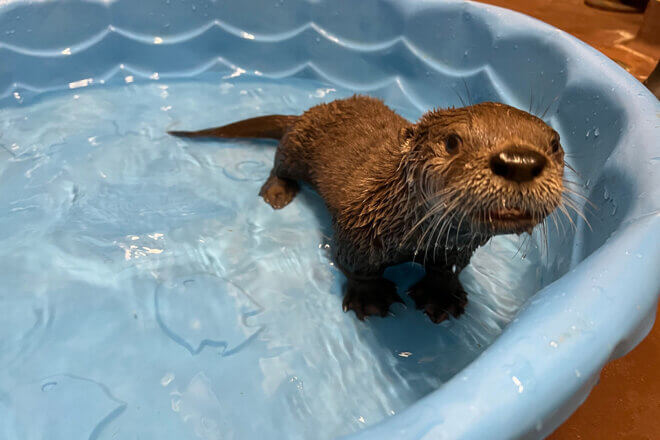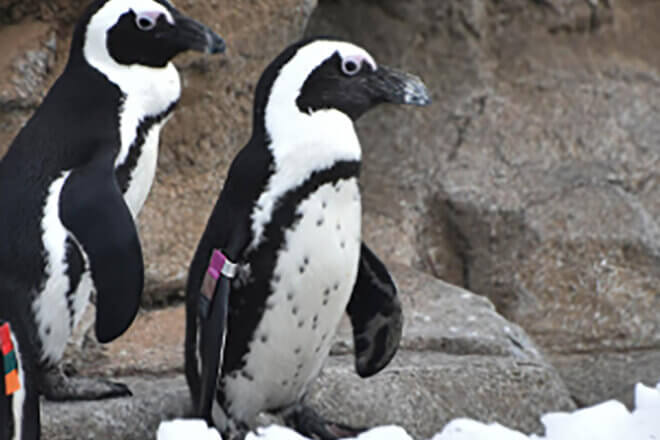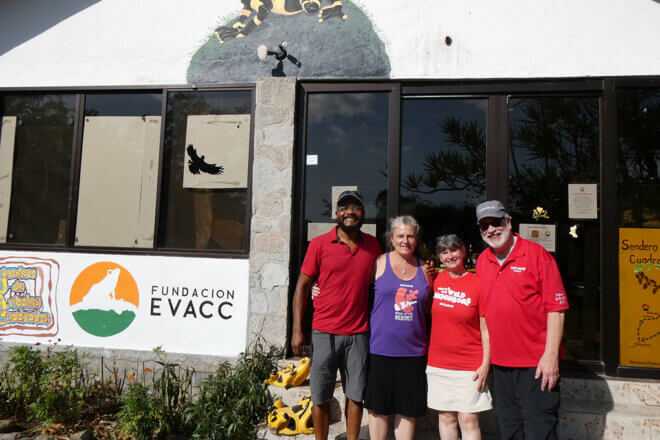BALTIMORE, MD – This winter when Project SNOWstorm co-founder Dave Brinker asked the Maryland Zoo for assistance testing a new GPS transmitter for tracking snowy owls, Dr. Ellen Bronson, sr. director of animal health, conservation, and research and Jennifer Kottyan, avian collection and conservation manager at the Zoo, welcomed the chance to help by fitting the test unit on the Zoo’s male snowy owl (Bubo scandiacus). Dr. Bronson is also part of Project SNOWstorm’s veterinary team. “We are the only Zoo participating in Project SNOWstorm,” noted Dr. Bronson, “We were happy to offer the snowy owl as a way for him to help contribute to ongoing scientific research for his species.” The Maryland Zoo maintains the Project SNOWstorm BioBank, and the Zoo’s licensed veterinary technicians process and analyze all samples collected from the snowy owls banded and tagged by the group.
![]()
Project SNOWstorm was launched seven year ago during a major irruption of snowy owls, when the birds migrated south in unusually large numbers from their summer breeding grounds. This presented a tremendous opportunity for scientists to learn more about one of the world’s largest owl species.
At the time, Dave Brinker and his colleagues were seeking to quickly adapt existing technology to fit a species that had only rarely been fitted with transmitters. The GPS/GSM units used were manufactured by New Jersey-based Cellular Tracking Technologies (CTT), were about the size of a small matchbox with a solar panel on the top and weighed a little less than two ounces. The transmitters can record an owl’s location, altitude, and flight speed as often as every six seconds, but are typically programmed to collect location data every 30 minutes. Data points are delivered to Project SNOWstorm three times a week via cell phone towers. The data points offer tremendous insight into the movement of these snowy owls – where and when they are resting, moving, hunting, or migrating.
“That first winter, we based our choices on size, shape and fit using the only proxy we had at hand — a young male snowy owl that had died after being brought to a Pennsylvania rehabilitation facility, and which was sent to us,” said Brinker. “The transmitter is attached with a harness of quarter-inch-wide woven tubular ribbon, which fits around the wings and body like a backpack, with the transmitter sitting high in the middle of the back, at the owl’s center of gravity. Altogether, everything — transmitter, harness, leg band — weighs no more than 3% of the bird’s body weight, a threshold which, based on decades of raptor telemetry, is widely accepted as safe.”
Project SNOWstorm has deployed over 90 of the transmitters on the backs of wild snowy owls over the past seven years. In that time a lot has been learned about the pros and cons of the initial transmitter design. One of the biggest challenges is keeping the solar panel clear of feathers. Snowy owls have deep, thick plumage, and some individuals preen the transmitter deep into their back feathers covering the solar panels. Although snowy owls usually roost in the open, many of them habitually face the sun all day, so their backs and their transmitters’ solar panels are in the shade, and if the panels are also covered with feathers, they are unable to charge effectively.
This year CTT proposed changes to the transmitter case design making it a bit longer, more narrow and thicker, all of which should make the unit even more stable on the bird’s back and also keep the solar panel away from occluding feathers.

Changes in the 3D print manufacturing process also make the case significantly lighter, which helps reduce the already small load a fitted owl would carry. It was this new design Dave Brinker fitted to the Zoo’s snowy owl to test the prototype “It was pretty cool to see the old design versus the new and to see how Dave actually puts the backpack on the owls,” said Kottyan. “Slipping on the harness went easily and quickly.”
Over the past two months Zoo staff have been monitoring the owl for any signs of discomfort and noted that ever since being fitted with the transmitter he has ignored it. “There are no problems at all to report,” continued Kottyan. “He is seemingly oblivious to the piece of equipment on his back.” He will continue to wear the transmitter through the summer at least, while the veterinary staff and his animal care team will continue to observe him to ensure his well-being.
“We were really pleased with how the test unit rides on the owl, and how it remains well above his feathers. Regular check-ups by the Zoo’s animal care staff have shown no unexpected problems with fit or wear,” stated Brinker. “We’re grateful to Dr. Bronson and the staff at the zoo for welcoming the opportunity for their male to contribute to our understanding of his species.”
Background
Project SNOWstorm, now in its seventh year, is a multi-national effort that brings together biologists, state and federal wildlife veterinarians and pathologists, telemetry experts, citizen scientists, and the Maryland Zoo in Baltimore in an effort to better understand the summer and winter ecology of snowy owls. While a large part of the project involves tracking snowy owls by GPS transmitter, biological samples are also taken from participating birds to glean information about their health. The Maryland Zoo maintains the Project SNOWstorm BioBank, and the Zoo’s licensed veterinary technicians process and analyze all samples received.





Share this article